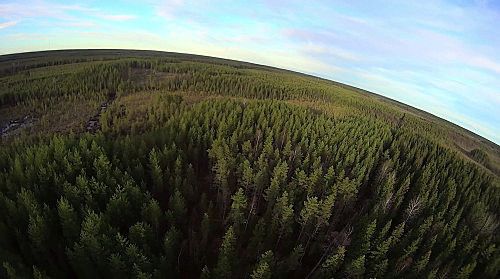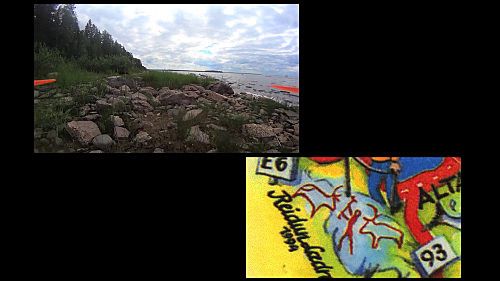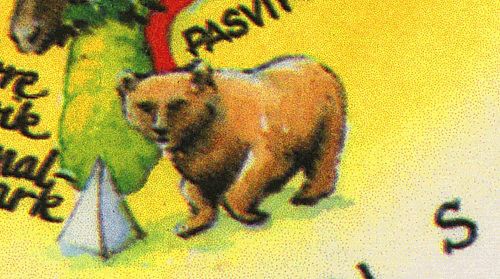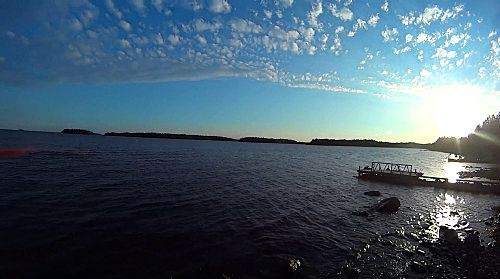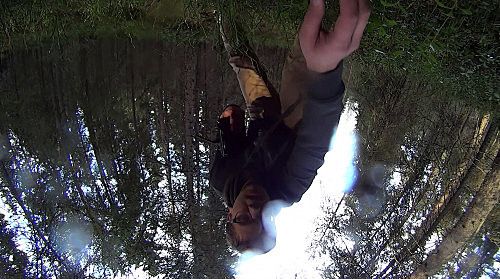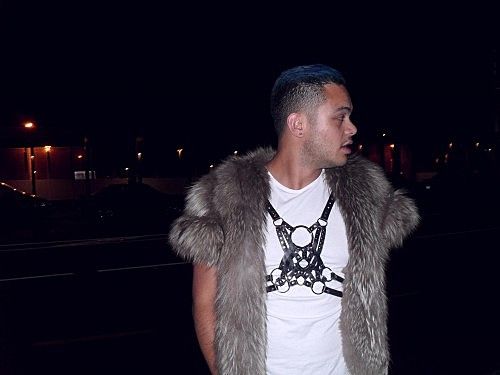In Sequence, In Parallel: Dan Munn's Drone Translations
Answered only by Fibonacci Sequence, Daniel Michael Satele speaks to NZ artist Dan Munn on two trips through the Sápmi region - one by drone, one by a stylised postcard of bears and tents - that come together in his recent video work.
With shows in New Zealand, Australia and Europe in recent years, and a Master of Fine Arts from Goldsmith’s College in London, Dan Munn is definitely an artist to watch in the decade to come. His work has fascinated me for several years now and, if you’ll forgive the cliché, it’s unlike anything else I’ve seen around. In an era where virtually anything might be considered art, this is no mean feat.
When I invited Dan to do an interview with me he responded with both enthusiasm and reservation. He was keen, while at the same time proposing an unusual format and procedure for it. Noticing that my previous interviews feature images of the interviewee’s work, he asked me to select a set of images from the recent Postcard Choreographyvideo on his website. I was then to ask a question, or make a claim, about the image, to which he would reply. However, instead of a responding once to each question, Dan’s replies would follow a schedule based on the Fibonacci sequence: 0, 1, 1, 2, 3, 5, 8, 13, 21 etc. He would make no reply to my first question (“0”); two replies to my fourth question, and so on. We followed this procedure up to the seventh image, where Dan gave eight replies to my question, at which point we agreed that the interview was long enough.
In following Dan’s wishes, this interview focuses more on Postcard Choreography (a 2013 video work originally created to be viewed on two monitors, documenting the same area of Sápmi in two distinct ways), in contrast withmy typical focus on an individual’s art practice more generally.
1. I feel like there is a kind of play on the idea of a “horizon” in this work: the horizon being the limit of what one can see while also playing a role in in the derivation of one’s sense of location in space. That’s almost an analogy for the disorienting quality I often find in your work: it’s as though the horizon keeps moving.
2. I also noticed that there are different kinds of conversations going on: the recorded conversations (one with a man, one with a woman) and the “conversation” between the two modes of representation of the landscape.
1. In this conversation the drone footage draws out in space one choreography at a time, and the postcard acts as an index of these choreographies.
3. But the postcard gives us a caricatured version, a kind of “cultural” landscape, while the drone footage is giving us virtually raw visual information which seems to put us in touch with real “nature,” at least as much as any documentary does.
1. That’s true, the footage tries to follow the stylised lines of an idea of movements (of a snowmobile, a reindeer, a man on skis) from the postcard, and in its failure to articulate that idea it emphasises the extent of its stylization.
4. You’ve used the word “choreography”, but what about cartography? Maps are often thought of as neutral, instrumental and objective; but they also express an historically and culturally specific way of thinking about space and locating oneself in it.
1. I decided in the end to use this kind of informal and very touristy “map” (if you would even call it that) to think through the experience I had as a visitor; I bought new snow boots, I borrowed a thermal sleeping bag, I put my body to work in rather basic ways like the people on this map.
2. The equivalent representation of people and animals frozen in motion on this card echoes the way in which the indigenous people of the region are presented as having an environmentally determined way of life, the natural landscape becoming a culture one through traditional activities. This is seen for instance in the annual reindeer migration, where emphasis is placed on the migration being carried out in line with the natural inclinations of the animals and not according to a set calendar.
5. So in this work, you're perverting the typical act of tourism? I mean, you took a trip which gave you the raw material for this work, but this work isn’t the thing most people would do as a result of their visiting this destination.
1. I think most people try to bring something back. What I wanted to bring back was a few indicators and experiences of the various technologies at play within tourism.
2. In a sense, I wanted to do what tourists who live with the reindeer herders during week-long trips are doing, trying to imagine what it would be like to return to traditional technologies for a fixed period. I felt like I accomplished this in certain moments, such as when I came to the end of snowmobile tracks while hiking above the city and had to turn back.
3. Jan Helmer Olsen, who does one of the voice-overs in the video, has lived in Norway’s indigenous capital of Karasjok all his life; he produces photos for camp sites, museums, the city council, etc. I wanted to know how the ‘close to nature’ slogan of far north tourism related to him as someone in the industry.
6. I think people would like to hear about how this particular work relates to your art practice more generally. Are there any particular artists that have influenced you, or is there any label you accept as appropriate to the kind of art you make?
1. My interest in this region originally came out of thinking about the ways that areas with similar climates, and subsequently agriculture and industry, can be connected despite of their distance (spatial, cultural, political, etc) from one another.
2. In a sense the work is investigating, coming to terms with, pushing against, what might define a place. My interest in this might come from spending a lot of my childhood in Auckland, which I see one of the country's key gateways, a city that (to a certain extent and for better or worse) takes on the role of representing the rest of New Zealand.
3. In my first year of studying art, in Wanganui, I shot a video in which I made a sandwich with a friend, and we used a chess-timer, taking turns constructing it. I’m very interested in how time works in isolated regions like the far north, how history is continually re-written and re-enacted in these areas.
4. The interviews and reviews I have done as a writer and curator parallel the collaborative aspect of my video and sculpture works; here I contacted a Finnish Youtube user, Santtu Pousi, who kindly agreed to work with me on this project. This shot (above) captures the view from the sunny deck of his parents’ place and their private perspective and use of this “timeless” landscape.
5. The structure for this conversation is loosely based on the “hard sci-fi” novel Dragon’s Egg, physicist Robert Forward's tale of an alien race who experience life 100 times faster than humans. The encounter between the 'Cheela' and the human astronauts is defined by temporal disjunction, operating alternately as both dialogue and monologue.
7. Is this you pictured above? I notice that you sometimes appear in your work as an actor or an agent enacting a procedure you’ve come up with but it’s not “self-expressive” in any obvious sense. I’m wondering how you conceive of the role of your “self” in your work… Is your “self” another kind of “locality” you’re dealing with or am I way off the mark?
1. This is Santuu, who I worked with remotely from London. He was generally very composed in the unintentional portraits like this one, moving about in a considered way as he focussed on monitoring and remotely controlling the drone machinery, occasionally collecting the apparatus after it fell from the sky.
2. Having spent my school years in the Midwestern U.S, your description of this as an inexpressive portrait makes me think of Billy Bob Thornton’s character in the Coen Brothers’ The Man Who Wasn’t There (“I don't talk much, I just cut the hair”) It’s the portrait of a worker who in the moment becomes not much more than an operator of tools and embodiment of the processes of the workplace.
3. I guess that “yourself-as-a-locale” is a post-structuralist approach in which we have different readings or perspectives on a situation. The second voice-over in the video is Alice May Williams, a fellow student at Goldsmiths College, who travelled to the Tromso in Norway on a cycling trip in 2010. She talks for instance about how reindeer in the far north would stand dead still in the middle of the road as she tried to cycle by, her personal momentary encounter with that geography.
4. I asked Santtu what he had been thinking when he was doing the bird, he emailed back “Maybe it could be some bird of prey looking up for small catch. Something like this (“hiirihaukka” in Finnish).
5. I recently saw this great film Alpi by Armin Linke on Vdrome.org that focuses on the image of the Swiss Alps and includes a narrated bus tour of a mining operation; in a way the vehicle's tame choreography and the tour guide's nostalgic tone are a model for how tourist experiences frame the technologically state-of-the-art oil and mineral industries in remote areas.
6. In Denis Wood’s The Power of Maps the chapter “Every Map Shows This... But Not That” describes the subjective decision-making that takes place in the production of maps like the postcard in the video. For example, the estimated €100 million spent by the Norwegian Public Roads Administration between 2004-2015 on National Tourist Routes were on roads already established for shipping purposes, to and from industrial workplaces not covered by the map. Instead we have displayed the industries of yesterday, now surplus recreational activities.
7. Art historian Miwon Kwon ends One Place After Another by stating that the degree to which we feel it necessary to produce the difference and authenticity of the local "only highlights the degree to which they are already lost to us". The preservation of past places and ways of life is always also a portrait of us (and how we are at its moment of creation).
8. In my interview with Jan Helmer he describes a moment with some of the same physical humour I think is present in the drone translations of Postcard Choreographies. “It's very funny to see people from Hong Kong, they have never seen snow before, and walking in the snow is very difficult and taking pictures at 30 below. They say 'how can you walk so fast in the snow?' (laughs), they are falling...”

